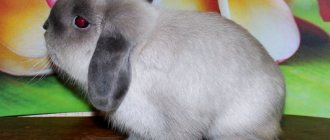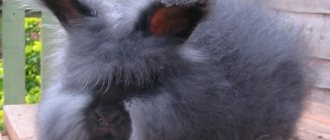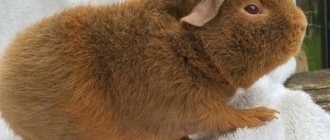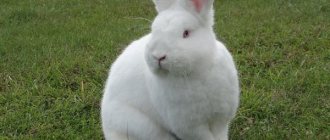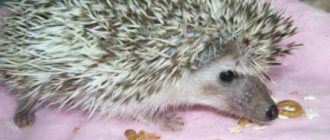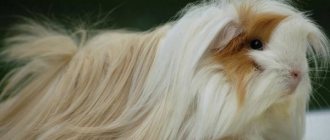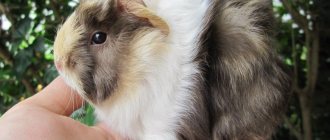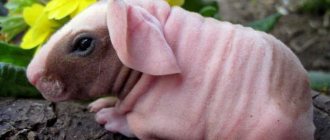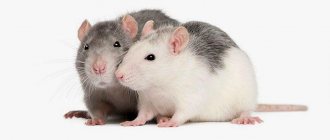Fold-eared rabbits, whose faces resemble small lambs in appearance, were described in his works by the naturalist Charles Darwin. During his extensive experience of traveling around the world, the scientist more than once admired these cute creatures. You will learn more about the Dwarf Ram rabbits in this article.
Lop-eared rabbit “Dwarf ram”
Decorative breed of rabbits “Dwarf Ram”
The breed is the result of crossing a dwarf rabbit and a French ram
Description of appearance
Now let's take a closer look at what representatives of decorative rabbits of the dwarf ram breed usually look like.
| Appearance | |
| Color | Dark and light gray, beige, white, black, brown. There are types that are completely painted in one color, there are two- and three-color |
| Torso | Well-built, proportional, with well-developed muscles |
| Head | Large, round, with a wide forehead. Muzzle flattened |
| Eyes | Almond-shaped, with a wide brown iris and a large round pupil |
| Ears | Oval in shape, hanging below the chin no less than 1.5–2 centimeters |
| Mustache | Long, thin, light in color |
| Neck | Short |
| Paws | Short, powerful |
| Tail | Short, fluffy |
| Claws | Short, arched, pointed |
Did you know? A newborn rabbit's ears will stick up. They will go down only by the end of the second or third month of the baby’s life. For some time, the cub can run around the house with one ear down and one ear sticking out.
History of breeding
The “Dwarf Ram” rabbit breed appeared as a result of the selection of two varieties: dwarf individuals and French fold rabbits. This breed quickly gained popularity all over the world: the small size of the animals with “mutton” faces amazed with their charm and beauty.
Such rabbits first became known at the end of the 18th century. In Russia, this breed became popular on the eve of the 2000s, thanks to the creation of several nurseries with animals imported from Europe.
Productive qualities
Dwarf female ram rabbits can easily produce offspring starting from the age of six months. With proper care, the female herself, without outside help, is able to give birth to 5-7 rabbits and feed them with her milk for quite a long time.
The main condition for this is the cleanliness of the cage, a sufficient amount of clean drinking water, regular feeding and the absence of irritating factors.
Offspring
Female rabbits are highly fertile. Females feed babies up to 2 months of age. An offspring of 8-10 rabbits is considered normal.
Important! Babies are born with long ears pressed to the head. Tenacious, survive without specific conditions or additional care. Life expectancy is up to 10 years.
Temperament
In general, decorative dwarf rabbits are very friendly and calm. However, sometimes among them there are real fidgets. Communication with them is reminiscent of communication with small children - they are inquisitive, playful, affectionate and childishly naive. Rams love independence.
Give your pet the opportunity to walk around the apartment on his own more often, but still keep an eye on him so that the rabbit does not accidentally get injured. If you pick up a small ram, it will immediately try to climb onto your back, as if demonstrating who is boss.
Character of fold-eared lambs
Also check out these articles
- clover honey
- The best varieties of spinach
- Apricot variety Pineapple
- Anemone Flower
The dwarf lop-eared ram rabbit has a calm, docile character. He doesn't make a lot of noise, and doesn't like noise at all. Due to the peculiarities of their ears, this species cannot determine where a loud sound is coming from, so when it hears it, it simply freezes in place. It is because of this trait that you should treat the animal very carefully and, if possible, isolate it from such stress.
Important!
Although the decorative lop-eared rabbit (ram) seems good-natured and quiet, if you do not pay attention to it, it will begin to demand it. Most often, the animal stands on its hind legs and stands there in the cage until it is petted!
Advantages and disadvantages
If you are seriously thinking about getting a dwarf sheep rabbit as a pet, you should familiarize yourself with all the possible pros and cons of such a decision.
- Among the advantages, these animals have the following qualities:
- Flexibility. This breed of decorative rabbits is considered the most tame. They quickly get used to people and willingly communicate with them.
- Ability to quickly get used to the crate and tray. You won't have to spend a lot of time and effort explaining to your little lamb where his place to sleep and the toilet are.
- The appearance of these lop-eared rabbits will not leave anyone indifferent. Their soft fluffy fur, cute floppy ears and the naive look of their large almond-shaped eyes delight both children and adults.
- The small size of adults of this breed, which is often limited to 1–2 kg. For such kids there is easily enough space in any, even small apartment.
- However, rabbits of the dwarf ram breed are also characterized by other, less positive characteristics:
- They don't like heat. When determining a place for the cage where the little ram will live, the owners should choose a place that will be protected from direct sunlight, radiators and heaters.
- They are afraid of drafts. The rabbit's cage should be located away from open windows and doors to minimize the risk of your pet catching colds.
- They love to chew on everything that comes their way. When letting the little ram walk around the apartment, it should not be left alone for a long time without supervision. Flowers, electrical wires, furniture legs, shoes - all this can be tested by a little fidget.
Choosing a cell
In order for the livestock to grow strong, it is necessary to create conditions for the full development of rabbits. To begin with, young animals must be planted separately from older livestock. Well, if the space allows, then arrange them according to gender. The fact is that such moments play an important role if the breeder wants to get high quality fur.
Taking into account all the above points, cells need to be purchased or constructed, taking into account the following details:
- partitions and bottom must be free and safe;
- so that the breed of lop-eared sheep can dig freely, it is necessary to install a bedding 15 cm deep;
- Instead of bedding, use newspaper or ordinary sawdust.
It is worth emphasizing that peat is not used for bedding. Because it emits a lot of dust, which is harmful to the respiratory tract of animals.
When choosing an area to place the cage, give preference to the shady area of the yard. Once a week it is necessary to disinfect the cells using a strong solution of potassium permanganate.
Experienced rabbit breeders recommend, if possible, pouring boiling water over rabbit houses, and then thoroughly ventilate and dry them. If it is not possible to carry out such a procedure, then it will be enough to thoroughly clean it and treat it with a soapy solution made from laundry soap.
Beginning livestock breeders often make one mistake: they keep the animals behind a metal cage.
It is not recommended to raise rabbits in such conditions, since the animals can injure their paws from the bars of the cells, as a result, even a minor injury can provoke the development of a defect.
If there is a need to fence off the rabbitry with a metal fence, then it should be insulated with wooden plywood. With the onset of cold weather, it is recommended to transplant long-eared pets into a greenhouse along with its cage. When there is severe frost outside, do not forget to heat the greenhouse so that the animals do not freeze. In general, the care and maintenance of rams is quite simple, the main thing is to feed the pets and keep them in clean cages.
Selection rules
If you nevertheless decide to have such a baby at home, in order to be sure to purchase a purebred representative of the breed, when purchasing it, you should pay attention to some of the features that distinguish real dwarf rams.
Signs of purebredness
The health and purity of a rabbit is indicated by:
- Animal fur. It should be shiny, thick, smell nice, and evenly cover the entire body of the animal.
- Eyes. They should not be inflamed, watery, or have crusts on them.
- Ears. The hearing organs of dwarf ram rabbits should be between 24 and 28 cm in size.
- Teeth should be straight and white.
- The entire body of a healthy, purebred rabbit should be elastic, muscular, strong and proportional.
Important! Remember that it is better to buy a dwarf ram in certified pet stores, where all the necessary veterinary certificates about the animal’s health are attached to the animal.
Signs of culling
If you notice one or more of the following signs in a rabbit that you are offered to buy, then it is better to refrain from the transaction:
- The animal's fur has bald spots, is dull and has an unpleasant odor.
- The little animal's eyes look inflamed, they are red and watery.
- The ears of an adult stick up or are much shorter or longer than normal.
- The rodent's teeth grow in uneven rows, are partially absent or significantly affected by plaque.
- The rabbit looks sick, does not want to make contact with people and looks very scared.
Disease
These animals have weak immunity and are often susceptible to disease. The most vulnerable organs are the gastrointestinal tract due to the fact that these animals are prone to overeating, ears and paws.
The decorative rabbit ram is the sickest among other breeds.
Signs of the disease:
- the fur becomes faded
- inactive, does not pay attention to external stimuli,
- the rabbit itches frequently and intensely,
- fluid or mucus drains from the eyes and nose,
- Redness and peeling appear on areas of the skin
- genitals - red and swollen,
- low appetite,
- the stool has an abnormal color and/or consistency.
Pododermatitis is a disease that often affects large breed rabbits. If the cage or enclosure is not constructed correctly, animals may develop calluses on their paw pads.
Features of keeping and caring for rabbits at home
Now let's figure out how to care for a decorative rabbit and what conditions it needs for full growth and development.
Home arrangement
You need to choose the most spacious cage for your rabbit. Because of their long ears, they need a lot of space to feel comfortable and not get injured in a cramped space filled with accessories.
It is better to place such a dwelling on a hill (a table or bedside table is suitable for this), in the quietest corner of the house, protected from the sun and drafts. Inside, your pet will need a house to rest and sleep, a feeder, a water bowl, a tray and a hay barn.
Sawdust can be added to the bottom of the cage as bedding. The role of toys for a little ram can be played by a ladder, a labyrinth or a slide placed in its cage. The optimal temperature in the room where the cage with the rabbit is located is considered to be +18…+23 °C, air humidity should vary from 50 to 75%.
Feeding ration
Small rabbits need to be fed three times a day in small portions, about one tablespoon of food. For adults, two meals a day, one and a half spoons of food, is enough.
Find out whether it is possible to feed rabbits quinoa grass, apples and other fruits, and also what not to feed rabbits at home.
The amount of food can be increased or decreased depending on how much your rabbit eats. The pet's litter box must be filled constantly. Hay is something that a rodent can eat in unlimited quantities without a threat to health.
In general, the diet of a decorative rabbit should consist of: mixed feed, various grains, twigs, mineral stones. The cage must have clean drinking water available 24/7. You can occasionally treat your pet with a piece of fresh vegetable or fruit, or a sprig of herbs.
At the same time, be sure to monitor the animal’s stool and stop giving treats at the first sign of diarrhea.
Important! When picking a twig from a tree for your pet, avoid stone fruits; they are strictly prohibited as food for decorative rabbits. It is better to give preference to willow, birch, oak, apple, pear, and poplar.
Care and hygiene
You need to clean your pet’s cage every day: change the tray, wash and fill the feeder and water bowl. You can change the sawdust at the bottom of the cage every 3-5 days. You cannot bathe decorative rabbits under running water. If the baby gets dirty somewhere, it is better to wash a separate section of the fur and immediately wrap the animal in a dry towel until it dries completely.
The claws of a small ram should be trimmed as it grows. Rabbits are vaccinated against myxomatosis and hemorrhagic disease at the age of one and a half months, provided that the baby has already gained a weight of at least 500 g.
If the vaccination is not comprehensive, then the interval between the first vaccination against myxomatosis and hemorrhagic vaccination should be 10 days. The next time these vaccinations will need to be done is at the age of 4.5 months and then every six months of the rodent’s life.
If you want to protect your pet from rabies, then this vaccination is done at the age of two to two and a half months.
In general, in order for your little rodent to live in comfort and develop harmoniously, you need to remember the following rules:
- Rabbits are shy animals; they love peace and quiet.
- In the warm season, every animal needs fresh air and moderate sunlight. Let your pet jump on the green grass outside after putting a harness on him.
- When your baby roams freely around the apartment, you should not leave him unattended. This is necessary both for the integrity of your household items and for its safety.
- Don't forget to take your dwarf ram to the vet regularly. It will help you monitor the animal’s health and promptly tell you if you need to adjust its daily or nutritional regimen.
How to tame a pet?
When making friends with your new pet, you don't need to be too intrusive. Carefully monitor the behavior of the small rodent and act based on your observations. Some rabbits love to sit in a person’s arms for a long time, happily eat from his hands and play games together with excitement.
Others, on the contrary, like to be alone, wander around the apartment on their own, studying the surrounding objects, eat only from the feeder and show nervousness when they are persistently petted.
The character of a rabbit is influenced by both its innate temperament and its mood at the moment. Show patience and flexibility in communicating with the little beech and, over time, you will achieve his complete trust and disposition towards you.
To speed up the process of building your bond, remember to bring a piece of treat for your pet each time you approach the cage. Speak to him in a calm, soft, gentle tone. Under no circumstances should you shout or hit your little lamb for disobedience or mischief.
Try inviting him to play games together, such as:
- knocking over skittles or empty plastic bottles;
- rolling a ball;
- walking through a homemade or purchased toy maze.
Many rodents like to rummage through a box of torn paper or chew on straw mats.
Feeding
For lop-eared dwarf rabbits, hay is the main source of nutrition in winter, and dried greens in summer. These foods contain large amounts of essential protein and carbohydrates, as well as vitamins and minerals. In addition, the diet must include:
- grain mixtures and cereals (preferably specialized);
- vegetables, seasonal fruits and root vegetables (washed, peeled, fresh or boiled);
- combined mixtures and mash.
It is recommended to limit the presence of legumes, cabbage and dairy products in the diet. In abundance, they can worsen digestion and cause dysbiosis. Animals must be fed twice a day. The daily food intake is twenty to thirty grams of food per head.
In winter, the diet of lop-eared rabbits is based on hay.
Solid and hard food, as well as branches of fruit and coniferous trees, must be present in the cages at all times. They are necessary for the systematic grinding of rabbits' teeth.
Rabbit breeding
Starting from the age of six months, decorative rabbits are considered already sexually mature and ready to bear children. Females easily make it clear that they are ready to reproduce - they begin to actively rake up the litter for themselves, thus building a “family nest.”
Did you know? When organizing a “date” for potential parents, it is worth placing the female with the male, and not vice versa, as is customary with many other animals. The male, finding himself in an unfamiliar cage, has little interest in the “bride”, concentrating all his attention on studying the new environment.
The behavior of a pregnant rabbit changes dramatically one and a half to two weeks after fertilization. She becomes more nervous and withdrawn, demanding more food and rest. The expectant mother's appetite especially grows a week or two before giving birth. The entire gestation period for rabbits takes an average of 31 days.
However, if there are 5 to 8 rabbits, the birth may occur a little earlier than planned, and vice versa - three or four cubs may stay in the mother’s tummy a little longer than expected.
Principles of selection for reproduction
For successful reproduction and breeding of healthy offspring, it is worth selecting the most thoroughbred and physically developed representatives of dwarf rams. The female and male must be sexually mature, strong, active rabbits, without diseases or birth defects.
The color of the coat does not matter much if the rodent's fur is thick enough, has a healthy shine and does not have bald spots. Healthy, muscular, proportionally built parents will almost certainly produce the same offspring.
Theoretically, dwarf ram rabbits can be crossed with representatives of other dwarf breeds, but newborn babies may not have floppy ears or a flattened muzzle, characteristic of rabbits of this breed.
Advantages
The fold-eared ram has a pleasant appearance
- The fold-eared ram has a pleasant appearance. He stands on a par with such beautiful rabbits as Hermelin, Lionhead, and Japanese.
- The ram is the calmest and most peaceful representative of the Zaitsev family.
- Unlike many other breeds (for example, silver rabbit, mardera, white giant, etc.), a ram can have different colors.
- The breed's coat is soft and fluffy. The wool is high quality. However, in terms of density it is inferior to the Russian Himalayan rabbit and chinchilla.
- Like the gray giant, the lop-eared ram is unpretentious in food and care.
- Unlike Flanders, Risen, Butterfly, etc., lop-eared rabbits do not eat their offspring. They conscientiously take care of newborn babies.
